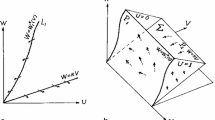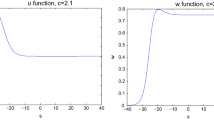Abstract
We establish the existence of traveling front solutions and small amplitude traveling wave train solutions for a reaction-diffusion system based on a predator-prey model with Holling type-II functional response. The traveling front solutions are equivalent to heteroclinic orbits in R 4 and the small amplitude traveling wave train solutions are equivalent to small amplitude periodic orbits in R 4. The methods used to prove the results are the shooting argument and the Hopf bifurcation theorem.
Similar content being viewed by others
Author information
Authors and Affiliations
Additional information
Received: 25 May 2001 / Revised version: 5 August 2002 / Published online: 19 November 2002
RID="*"
ID="*" Research was supported by the National Natural Science Foundations (NNSF) of China.
RID="*"
ID="*" Research was partially supported by the Natural Sciences and Engineering Research Council (NSERC) of Canada. On leave from the Department of Mathematics and Statistics, Dalhousie University, Halifax, Nova Scotia B3H 3J5, Canada.
Mathematics Subject Classification (2000): 34C35, 35K57
Key words or phrases: Traveling wave solution – Wazewski set – Shooting argument – Hopf bifurcation
Acknowledgements. We would like to thank the two referees for their careful reading and helpful comments.
Rights and permissions
About this article
Cite this article
Huang, J., Lu, G. & Ruan, S. Existence of traveling wave solutions in a diffusive predator-prey model. J. Math. Biol. 46, 132–152 (2003). https://doi.org/10.1007/s00285-002-0171-9
Issue Date:
DOI: https://doi.org/10.1007/s00285-002-0171-9




